Question
The diagram shows a prokaryotic cell.
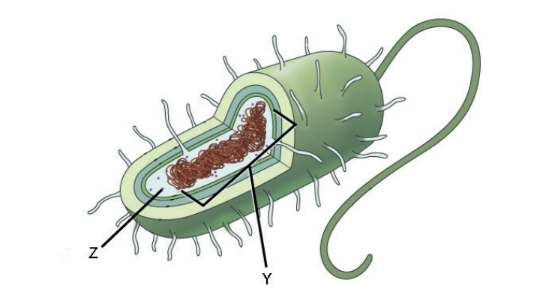
What are the structures labelled Y and Z?
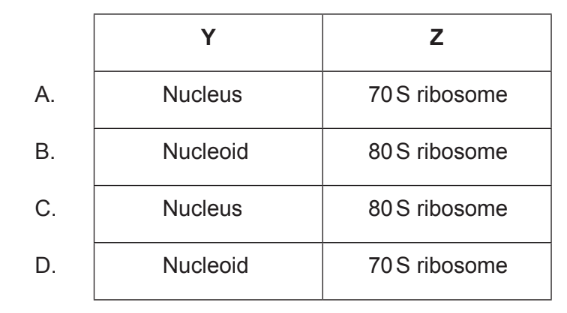
▶️Answer/Explanation
Ans:D
A nucleotide is an organic molecule that is the building block of DNA and RNA. It has three parts: a nitrogenous base, a five-carbon sugar, and a phosphate group. The nitrogenous base can be a purine (adenine or guanine) or a pyrimidine (cytosine, thymine or uracil). The sugar can be ribose (in RNA) or deoxyribose (in DNA). The phosphate group can have one, two or three phosphates attached to the sugar.
Nucleotides have many functions in living cells. They store and transmit genetic information, they provide chemical energy for cellular processes, they participate in cell signaling and enzyme reactions, and they form various coenzymes and cofactors. For example, ATP (adenosine triphosphate) is a nucleotide that acts as the energy currency of cells. NAD (nicotinamide adenine dinucleotide) and FAD (flavin adenine dinucleotide) are nucleotides that act as electron carriers in cellular respiration. cAMP (cyclic adenosine monophosphate) and cGMP (cyclic guanosine monophosphate) are nucleotides that act as second messengers in signal transduction pathways. Coenzyme A is a nucleotide that is involved in fatty acid synthesis and oxidation.
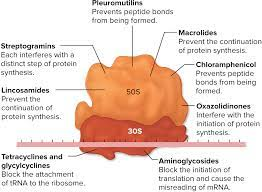
A 70S ribosome is a type of ribosome that is found in prokaryotic cells such as bacteria. It is also found in some eukaryotic cell organelles such as mitochondria and chloroplasts. A 70S ribosome consists of two subunits: a small 30S subunit and a large 50S subunit¹². The subunits are composed of ribosomal RNA (rRNA) and ribosomal proteins (RPs). A 70S ribosome has a total of 55 protein molecules and 3 molecules of RN. It has a weight of about 2.7-3.0 million Daltons and a sedimentation coefficient of 70.
A 70S ribosome is involved in the process of protein synthesis or translation³. It binds to a messenger RNA (mRNA) molecule that carries the genetic information for the protein sequence³. It also interacts with transfer RNA (tRNA) molecules that carry the corresponding amino acids to the mRNA codons. The 70S ribosome has two sites for tRNA binding: the aminoacyl site (A site) and the peptidyl site (P site). The 70S ribosome catalyzes the formation of a peptide bond between the amino acids at the P site and the A site, and then moves along the mRNA to expose a new codon at the A site⁶. This cycle repeats until the 70S ribosome reaches a stop codon on the mRNA, which signals the termination of translation.
The 70S ribosome is different from the 80S ribosome, which is found in eukaryotic cells. The 80S ribosome has a larger size and weight, and consists of a small 40S subunit and a large 60S subunit². It has more protein and RNA molecules than the 70S ribosome, and has a different RNA-to-protein ratio. The 80S ribosome also has an additional site for tRNA binding: the exit site (E site), where the tRNA leaves after donating its amino acid³. The 80S ribosome is not affected by antibiotics that inhibit protein synthesis in prokaryotes by targeting the 70S ribosome.
Question
The micrograph of a section through a plant stem shows at least ten different types of cells.

What explains the differences between these cells?
A. Only one gene is expressed in each cell type.
B. Different genes are expressed in each cell type.
C. Only useful genes remain in the DNA of each cell type.
D. Changes in the DNA sequence take place when these cells develop.
▶️Answer/Explanation
Markscheme
B
Question
What do chloroplasts and mitochondria have in common?
Both are found in the cells of Filicinophyta.
Both contain grana.
Both occur in all eukaryotic cells.
Both are found in a Paramecium.
▶️Answer/Explanation
A is not correct answer.
The answer is B) Both contain grana.
Chloroplasts and mitochondria are both organelles found in eukaryotic cells. Chloroplasts are found in plant cells and are responsible for photosynthesis, while mitochondria are found in both plant and animal cells and are responsible for cellular respiration. Both chloroplasts and mitochondria contain their own DNA and ribosomes, and are thought to have originated from free-living bacteria that were engulfed by ancestral eukaryotic cells. Additionally, both organelles contain internal membrane systems, with chloroplasts containing thylakoid membranes that are organized into grana, and mitochondria containing inner membranes that are folded into cristae.
Question
What is the structure labeled X in the electron micrograph of a rat liver cell?
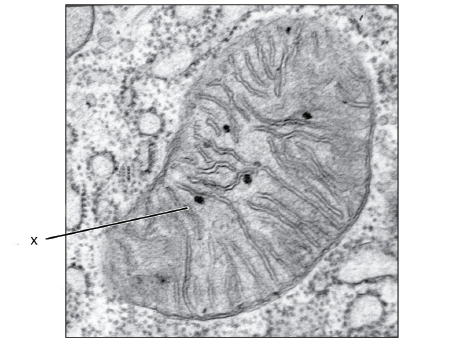
A. Ribosome
B. Lysosome
C. Mitochondrion
D. Nucleus
▶️Answer/Explanation
Markscheme
Ans:C
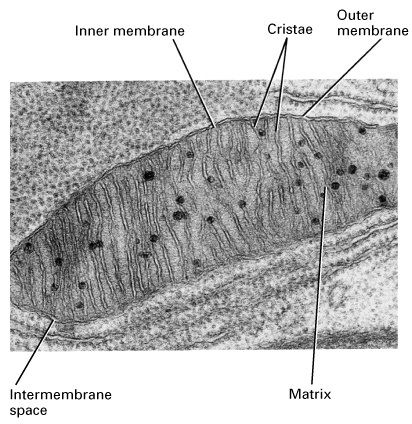
Mitochondria are organelles found in most cells that are responsible for generating energy in the form of ATP (adenosine triphosphate) through the process of oxidative phosphorylation. They are typically round to oval in shape and range in size from 0.5 to 10 μm³. Mitochondria are unlike other cellular organelles in that they have two distinct membranes and a unique genome and reproduce by binary fission; these features indicate that mitochondria share an evolutionary past with prokaryotes (single-celled organisms).
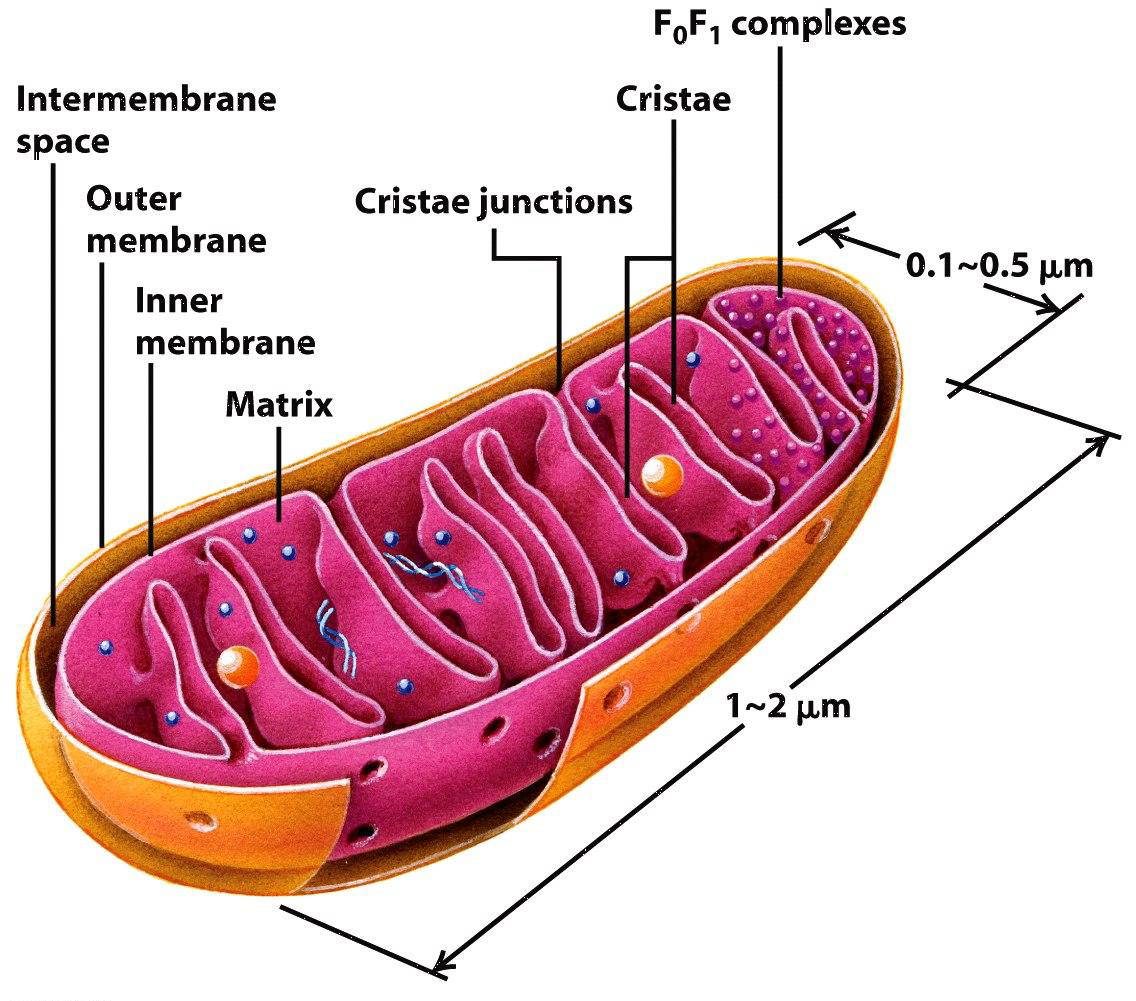
Functions. Mitochondria are sites of cellular respiration. They use molecular oxygen from air to oxidise the carbohydrates and fats (lipids) p[resent in the cell to carbon dioxide and water vapour. Oxidation releases energy, a portion of which is used to form ATP (adenosine triphosphate). Since the mitochondria synthesize, energy-rich compounds (ATP) they are known as ‘power house’ of the cell. The energy stored in ATP is used by the cell.